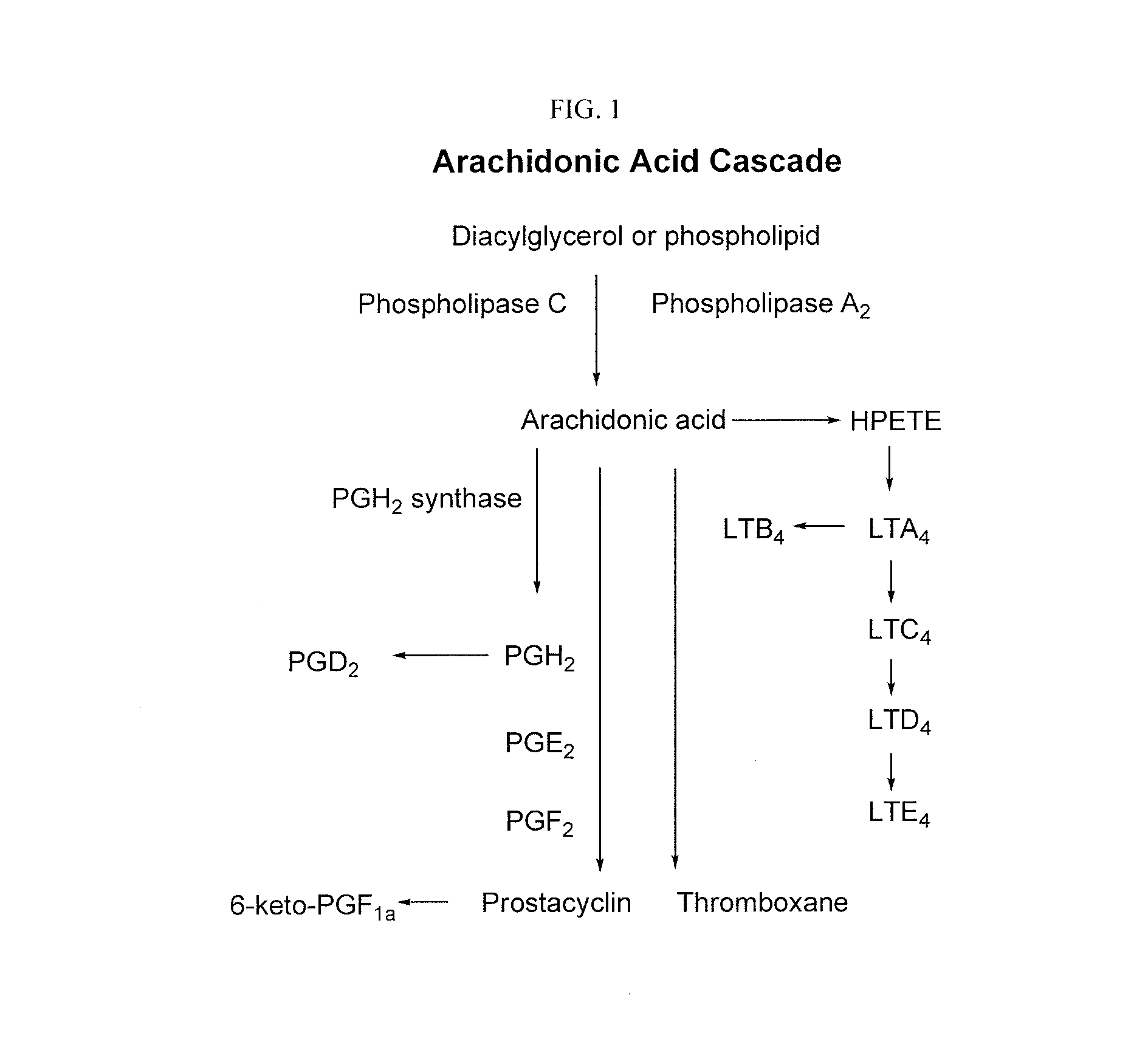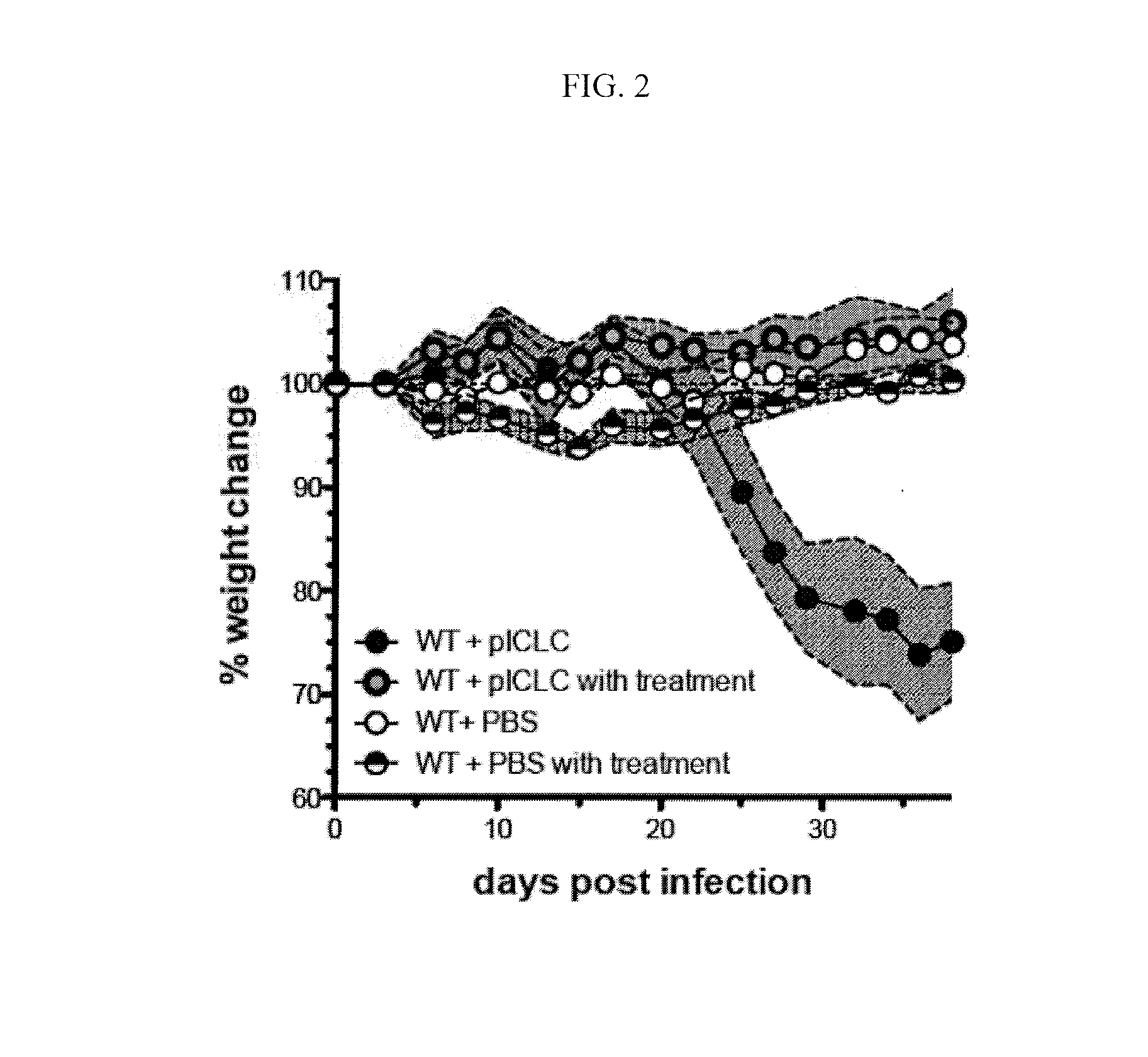Treatment and prevention of diseases mediated by microorganisms via drug-mediated manipulation of the eicosanoid balance
a technology of eicosanoid balance and drug-mediated manipulation, which is applied in the direction of antibacterial agents, drug compositions, antiparasitic agents, etc., can solve the problems of tuberculosis remaining a leading cause of death, disease recurrence, death and disfigurement of the afflicted,
- Summary
- Abstract
- Description
- Claims
- Application Information
AI Technical Summary
Benefits of technology
Problems solved by technology
Method used
Image
Examples
example 1
[0077]This example demonstrates the effect of co-administration of zilueton and PGE2 to C57BL6 mice infected with Mycobacterium tuberculosis that are concurrently treated with poly-ICLC.
[0078]Four groups of five C57BL / 6 mice (“B6 mice”) were used in this study. All four groups were exposed to M. tuberculosis at a level of 100-150 colony forming units via intranasal aerosol route. A control group of five mice was not further treated. A comparative group was treated twice weekly via intranasal administration of poly-ICLC, which is polyinosinic-polycytidylic acid condensed with poly-L-lysine and carboxymethylcellulose (Oncovir Inc., Washingon, D.C.). The comparative group of five mice was not further treated. A test group of five mice was treated with zileuton, which was administered in drinking water at a concentration of 6 mg / mL, PGE2, which was administered intranasally at a concentration of 6 μg / 30 μLin phosphate buffered saline per mouse twice a week, and poly-ICLC. A second contr...
example 2
[0083]Two groups of five IL-1a / bDKO− / − (IL-1α / β double knock-out) mice and one group of five C57BL / 6 mice were used in this study. The C57BL / 6 mice were used as a control.
[0084]All three groups were exposed to M. tuberculosis at a level of 100-150 colony forming units via intranasal aerosol route. A test group of five IL-1a / bDKO− / − mice and a control group of C57BL / 6 mice were treated with zileuton, which was administered in drinking water at a concentration of 6 mg / mL, and PGE2, which was administered intranasally at a concentration of 6 g / 30 μLin phosphate buffered saline per mouse twice a week. A comparative group of IL-1a / bDKO− / − mice was not treated with zileuton and PGE2.
[0085]None of the comparative group of IL-1a / bDKO− / − mice survived past 40 days post-infection. One of the test group of five IL-1a / bDKO− / − mice died at day 40, with the remaining four mice surviving more than 40 days but less than about 65 days. All of the control group of C57BL / 6 mice survived more than 60 d...
example 3
[0088]C57BL6 mice were infected with 200 CFU of Mtb by the aerosol route and given poly-ICLC twice a week. One group of mice were treated with PBS as a control and was not treated with poly-ICLC. A second group of mice was not further treated. A third group of mice was further treated with PGE2. A fourth group of mice was further treated with PGE2 and zileuton. A fifth group of mice was further treated with zileuton alone.
[0089]After a period of time, the colony forming units (“CFU”) in lungs were determined for each group of mice, and the results graphically illustrated in FIG. 5.
[0090]As is apparent from the results depicted in FIG. 5, the control group had approximately 7.4 log10 CFU. Mtb-infected poly-ICLC-treated mice had approximately 8.9 log10 CFU. Mtb-infected poly-ICLC-treated mice that were further treated with PGE2 had approximately 9.2 log10 CFU. Mtb-infected poly-ICLC-treated mice that were further treated with PGE2 had approximately 8.9 log10 CFU. Mtb-infected poly-ICL...
PUM
| Property | Measurement | Unit |
|---|---|---|
| Immunogenicity | aaaaa | aaaaa |
| Antimicrobial properties | aaaaa | aaaaa |
Abstract
Description
Claims
Application Information
 Login to View More
Login to View More - R&D
- Intellectual Property
- Life Sciences
- Materials
- Tech Scout
- Unparalleled Data Quality
- Higher Quality Content
- 60% Fewer Hallucinations
Browse by: Latest US Patents, China's latest patents, Technical Efficacy Thesaurus, Application Domain, Technology Topic, Popular Technical Reports.
© 2025 PatSnap. All rights reserved.Legal|Privacy policy|Modern Slavery Act Transparency Statement|Sitemap|About US| Contact US: help@patsnap.com



